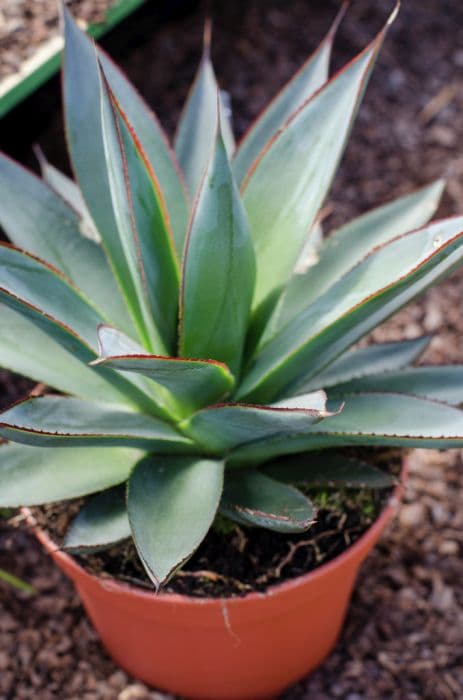Parry's Agave Agave parryi

ABOUT
The Parry's agave, also known as the mescal agave, is a succulent plant that is distinctively known for its rosette of thick, fleshy leaves. These leaves are a blue-green to gray-green color and possess a waxy coating that helps to reduce water loss. The leaves are broad and robust at the base, tapering to a point at the end. Remarkably, each leaf's point is tipped with a dark brown to black, sharp spine which is quite formidable. Along the margins of the leaves, there are also small, regularly spaced teeth which can be dark in color and are sharp as well. The overall shape of the Parry's agave rosette is somewhat symmetrical and can appear compact, giving the plant a very structured, architectural feel. During the flowering period, which happens only once near the end of the plant's life, a tall flower stalk emerges from the center of the rosette. The flowers are arranged in clusters on the upper parts of the stalk and are usually yellow or pale green in color, attracting pollinators such as bees, hummingbirds, and bats before the plant completes its life cycle.
About this plant
 Names
NamesFamily
Asparagaceae
Synonyms
Parry's Agave, Mescal Agave, Artichoke Agave
Common names
Agave applanata, Agave huachucensis, Agave neomexicana, Agave parryi var. huachucensis.
 Toxicity
ToxicityTo humans
The plant in question is Parry's Agave. This plant is not typically considered poisonous to humans, but it can cause skin irritation or allergic reactions in some individuals due to the sap's composition, which contains calcium oxalate crystals and various other compounds. Additionally, the plant's pointed tips and edges may cause physical injury if not handled with care. If ingested, parts of the plant may be toxic. Symptoms of internal exposure, although quite rare, could include gastrointestinal discomfort or irritation. It is advisable to avoid ingesting any part of Parry's Agave to prevent any potential adverse effects.
To pets
Parry's Agave is the plant in question. This agave species is not considered highly toxic to pets, but like in humans, the sap can cause irritation or allergic reactions in some animals. Pets may experience gastrointestinal upset if they ingest parts of the plant. This can include symptoms such as vomiting or diarrhea. Additionally, the sharp spines and edges of the plant could cause physical injuries to pets if they come into contact with or attempt to chew on the plant. It is recommended to keep pets away from Parry's Agave to prevent any potential harm.
 Characteristics
CharacteristicsLife cycle
Perennials
Foliage type
Evergreen
Color of leaves
Blue-green
Flower color
Yellow
Height
2 feet (0.61 meters)
Spread
2 feet (0.61 meters)
Plant type
Succulent
Hardiness zones
5
Native area
Southwest USA
Benefits
 General Benefits
General Benefits- Drought Resistance: Agave parryi, commonly known as Parry's Agave, is highly tolerant to drought, making it an ideal plant for xeriscaping and arid landscape designs.
- Low Maintenance: It requires minimal care once established, needing little watering or pruning, which saves time and resources.
- Attracts Wildlife: The plant produces attractive blooms that can attract hummingbirds and beneficial pollinators to the garden.
- Erosion Control: The extensive root system of Parry's Agave helps to stabilize soil and prevent erosion, particularly on slopes or in areas with loose soil.
- Longevity: It is a long-lived plant that provides a stable and enduring element in gardens or natural landscapes.
- Architectural Interest: With its rosette of spikey leaves, Parry's Agave adds visual interest and dramatic accents to garden designs or as a specimen plant.
- Edible Uses: The sap and the heart of the agave plant are traditionally used to make sweeteners and alcoholic beverages, though this usage requires careful preparation to avoid toxicity.
 Medical Properties
Medical PropertiesThis plant is not used for medical purposes.
 Air-purifying Qualities
Air-purifying QualitiesThis plant is not specifically known for air purifying qualities.
 Other Uses
Other Uses- Agave parryi, commonly known as Parry's agave or mescal agave, can be used for landscaping in arid regions, as it is a drought-tolerant plant that adds a sculptural aesthetic to xeriscapes.
- The fibers extracted from the leaves of Parry's agave can be used to make ropes, mats, and textiles due to their strength and durability.
- The pointed leaf tips and stiff leaf spines of Parry's agave have historically been used as needles and awls in traditional crafting.
- Agave parryi can serve as a habitat and source of food for various wildlife, including birds and bees that feed on its nectar.
- The rosette formation of Parry's agave can be used in natural erosion control on hillsides and banks as its root system can help stabilize soil.
- Parry's agave can be used in the production of a distilled spirit known as mezcal, when the "piñas" or hearts of the plants are harvested and fermented.
- When dried and hollowed, the flower stalks of Agave parryi may be used as didgeridoos or other musical instruments.
- The plants can be grown as a natural fence due to the sharp spines and dense growth, providing a defensive barrier against trespassers and animals.
- Agave parryi sap can be fermented to produce pulque, a traditional Mexican alcoholic beverage.
- With its striking appearance, a potted Parry's agave can serve as an elegant and hardy living sculpture in an indoor or outdoor setting.
Interesting Facts
 Feng Shui
Feng ShuiThe Century Plant is not used in Feng Shui practice.
 Zodiac Sign Compitability
Zodiac Sign CompitabilityThe Century Plant is not used in astrology practice.
 Plant Symbolism
Plant Symbolism- Resilience - Agave parryi is known for its ability to thrive in harsh, arid environments, symbolizing enduring through tough conditions and survival against the odds.
- Adaptability - As a plant that can adapt to extreme climates, it represents the ability to adjust to various situations and remain flexible in life's journey.
- Conservation - Owing to its water-saving succulent nature, the Agave parryi stands for the principle of conservation, utilizing resources efficiently and sustainably.
- Longevity - The Agave parryi has a long life span, often taking years to flower, symbolizing patience and long-term vision.
- Protection - With its strong, pointed leaves, the Parry's agave can also symbolize protection and setting boundaries.
 Water
WaterThe Parry's Agave requires infrequent watering. In a landscape setting, you should water this agave every two to three weeks during hot, dry periods, decreasing to monthly or no water during cooler months. It is a drought-tolerant plant, so it's essential not to overwater it. When you do water, do so deeply, providing about 1-2 gallons, depending on the size of the plant and the dryness of the soil, allowing the water to penetrate down to the roots. Let the soil dry out completely between watering sessions.
 Light
LightParry's Agave thrives best in full sun conditions, meaning it should receive direct sunlight for at least six hours each day. The ideal spot for your Parry's Agave would be a south-facing location where it can enjoy unfiltered sunlight. Despite this preference, the plant is quite adaptable and can also tolerate partial shade, especially in extremely hot climates.
 Temperature
TemperatureParry's Agave prefers warm temperatures and can handle variance in climate. Ideally, it thrives in temperatures between 50°F and 85°F but can survive minimum temperatures down to 20°F. It's not frost-tender, but extended cold below this threshold may damage the plant.
 Pruning
PruningPruning Parry's Agave is largely unnecessary as the plant has a naturally attractive form. Pruning may only be required to remove any dead or damaged leaves, and this should be done carefully to maintain the rosette's appearance. The best time for pruning is in the spring or early summer when the plant is not in a dormant phase.
 Cleaning
CleaningNot needed
 Soil
SoilParry's Agave requires a well-draining soil mix, often composed of equal parts sand, perlite, and compost to ensure adequate drainage and aeration. The soil pH should be slightly acidic to slightly alkaline, ranging from 6.0 to 8.0. A cactus or succulent potting mix is often recommended as it mimics the natural gritty substrate these plants thrive in.
 Repotting
RepottingParry's Agave is a slow-growing plant and does not need to be repotted frequently. It should be repotted only when it has outgrown its current container, which can be every 3 to 5 years. Use a pot only slightly larger than the current one to avoid overpotting and ensure the soil mixture is well-draining.
 Humidity & Misting
Humidity & MistingParry's Agave prefers low humidity conditions and is well-suited to dry, arid environments. The best humidity level for this plant is between 10% and 30%. Avoid placing it in highly humid environments as this can promote rot and fungal diseases.
 Suitable locations
Suitable locationsIndoor
Place in bright light, allow soil to dry between waterings.
Outdoor
Plant in full sun, well-draining soil, water sparingly.
Hardiness zone
5-10 USDA
 Life cycle
Life cycleThe life cycle of Parry's Agave (Agave parryi) begins with seed germination, where the plant starts as a small seedling. The seedling then grows into a juvenile rosette, slowly maturing over several years—typically a decade or more—storing energy in its succulent leaves. During the mature stage, the rosette becomes robust and fully developed, focusing energy storage to prepare for flowering. Once reaching maturity, which can be after 10 to 30 years, the agave will initiate its once-in-a-lifetime flowering event, growing a tall flowering stalk, which can reach several meters in height, and blooming with numerous flowers that attract pollinators. After flowering and successful pollination, the plant produces seeds that are dispersed, often by birds or mammals. The parent plant typically dies shortly after seed setting, thus completing its life cycle.
 Propogation
PropogationPropogation time
Spring-Early Summer
Propogation: The most popular method of propagating Parry's Agave, Agave parryi, is through the use of offsets, which are small clones that the plant naturally produces around its base. The best time to propagate Parry's Agave by offsets is during the late spring or early summer when the plant is actively growing. Gardeners can carefully separate these offsets from the mother plant, ensuring they have a portion of roots attached. Once separated, the offset should be allowed to dry for a few days to form a callus on the cut surface, which helps prevent rot when planted. After the drying period, the offset can be planted in a well-draining soil mix, ideally in a container that allows enough room for root growth. Water sparingly at first to encourage root development, gradually increasing as the plant establishes itself.









